I have a polygon made of successive edges on a plane, and would like to subdivide it in sub-polygons being triangles or rectangles. Where can I find an algorithm to do this ? Thanks !
-
1Could you please post a picture with an example of what you are trying to do? There is a good chance that you'll come up with an acceptable algorithm in the process of drawing your picture, too. – Sergey Kalinichenko Dec 13 '11 at 15:55
-
Sorry for having been unclear. Basically I am working on an application that generates streets and parcels, parcels being the plane inside street intersections. I would like to subdivide the parcel in smaller ones, in order to put houses on the smaller lots. – Laurent Crivello Dec 13 '11 at 16:05
-
@LaurentCrivello: As missigno mentioned, this is a known problem. If you're looking for example code, [here's](https://github.com/yairchu/defend/blob/master/src/Geometry.hs) a short implementation in Haskell (look at `triangulatePolygon`) – yairchu Dec 13 '11 at 16:17
-
You might find [this Soulwire blog post](http://blog.soulwire.co.uk/laboratory/flash/recursive-polygon-subdivision) interesting. – PengOne Dec 13 '11 at 19:18
3 Answers
I was looking for an answer for this myself but couldn't find one. Tried to stitch together several pieces and here's the result.
This is not necessarily the most optimal routine but it did the job for me. If you want to increase performance, try experimenting with the code.
A brief description of the algorithm:
Using the boundaries of the original geometry itself, and the boundaries of its convex hull, and its minimum rotated rectangle, derive all possible rectangles.
Divide all rectangles into smaller squares of specified side length.
Drop duplicates using a rounded off centroid. (r: round off param)
Retain either those squares 'within' the geometry, or those that 'intersect' the geometry, depending on whichever is closer to the total number of required squares.
EDITED
New Solution
#### Python script for dividing any shapely polygon into smaller equal sized polygons
import numpy as np
from shapely.ops import split
import geopandas
from shapely.geometry import MultiPolygon, Polygon
def rhombus(square):
"""
Naively transform the square into a Rhombus at a 45 degree angle
"""
coords = square.boundary.coords.xy
xx = list(coords[0])
yy = list(coords[1])
radians = 1
points = list(zip(xx, yy))
Rhombus = Polygon(
[
points[0],
points[1],
points[3],
((2 * points[3][0]) - points[2][0], (2 * points[3][1]) - points[2][1]),
points[4],
]
)
return Rhombus
def get_squares_from_rect(RectangularPolygon, side_length=0.0025):
"""
Divide a Rectangle (Shapely Polygon) into squares of equal area.
`side_length` : required side of square
"""
rect_coords = np.array(RectangularPolygon.boundary.coords.xy)
y_list = rect_coords[1]
x_list = rect_coords[0]
y1 = min(y_list)
y2 = max(y_list)
x1 = min(x_list)
x2 = max(x_list)
width = x2 - x1
height = y2 - y1
xcells = int(np.round(width / side_length))
ycells = int(np.round(height / side_length))
yindices = np.linspace(y1, y2, ycells + 1)
xindices = np.linspace(x1, x2, xcells + 1)
horizontal_splitters = [
LineString([(x, yindices[0]), (x, yindices[-1])]) for x in xindices
]
vertical_splitters = [
LineString([(xindices[0], y), (xindices[-1], y)]) for y in yindices
]
result = RectangularPolygon
for splitter in vertical_splitters:
result = MultiPolygon(split(result, splitter))
for splitter in horizontal_splitters:
result = MultiPolygon(split(result, splitter))
square_polygons = list(result)
return square_polygons
def split_polygon(G, side_length=0.025, shape="square", thresh=0.9):
"""
Using a rectangular envelope around `G`, creates a mesh of squares of required length.
Removes non-intersecting polygons.
Args:
- `thresh` : Range - [0,1]
This controls - the number of smaller polygons at the boundaries.
A thresh == 1 will only create (or retain) smaller polygons that are
completely enclosed (area of intersection=area of smaller polygon)
by the original Geometry - `G`.
A thresh == 0 will create (or retain) smaller polygons that
have a non-zero intersection (area of intersection>0) with the
original geometry - `G`
- `side_length` : Range - (0,infinity)
side_length must be such that the resultant geometries are smaller
than the original geometry - `G`, for a useful result.
side_length should be >0 (non-zero positive)
- `shape` : {square/rhombus}
Desired shape of subset geometries.
"""
assert side_length>0, "side_length must be a float>0"
Rectangle = G.envelope
squares = get_squares_from_rect(Rectangle, side_length=side_length)
SquareGeoDF = geopandas.GeoDataFrame(squares).rename(columns={0: "geometry"})
Geoms = SquareGeoDF[SquareGeoDF.intersects(G)].geometry.values
if shape == "rhombus":
Geoms = [rhombus(g) for g in Geoms]
geoms = [g for g in Geoms if ((g.intersection(G)).area / g.area) >= thresh]
elif shape == "square":
geoms = [g for g in Geoms if ((g.intersection(G)).area / g.area) >= thresh]
return geoms
# Reading geometric data
geo_filepath = "/data/geojson/pc_14.geojson"
GeoDF = geopandas.read_file(geo_filepath)
# Selecting random shapely-geometry
G = np.random.choice(GeoDF.geometry.values)
squares = split_polygon(G,shape='square',thresh=0.5,side_length=0.025)
rhombuses = split_polygon(G,shape='rhombus',thresh=0.5,side_length=0.025)
Previous Solution:
import numpy as np
import geopandas
from shapely.ops import split
from shapely.geometry import MultiPolygon, Polygon, Point, MultiPoint
def get_rect_from_geom(G, r=2):
"""
Get rectangles from a geometry.
r = rounding factor.
small r ==> more rounding off ==> more rectangles
"""
coordinate_arrays = G.exterior.coords.xy
coordinates = list(
zip(
[np.round(c, r) for c in coordinate_arrays[0]],
[np.round(c, r) for c in coordinate_arrays[1]],
)
)
Rectangles = []
for c1 in coordinates:
Coords1 = [a for a in coordinates if a != c1]
for c2 in Coords1:
Coords2 = [b for b in Coords1 if b != c2]
x1, y1 = c1[0], c1[1]
x2, y2 = c2[0], c2[1]
K1 = [k for k in Coords2 if k == (x1, y2)]
K2 = [k for k in Coords2 if k == (x2, y1)]
if (len(K1) > 0) & (len(K2) > 0):
rect = [list(c1), list(K1[0]), list(c2), list(K2[0])]
Rectangles.append(rect)
return Rectangles
def get_squares_from_rect(rect, side_length=0.0025):
"""
Divide a rectangle into equal area squares
side_length = required side of square
"""
y_list = [r[1] for r in rect]
x_list = [r[0] for r in rect]
y1 = min(y_list)
y2 = max(y_list)
x1 = min(x_list)
x2 = max(x_list)
width = x2 - x1
height = y2 - y1
xcells, ycells = int(np.round(width / side_length)), int(
np.round(height / side_length)
)
yindices = np.linspace(y1, y2, ycells + 1)
xindices = np.linspace(x1, x2, xcells + 1)
horizontal_splitters = [
LineString([(x, yindices[0]), (x, yindices[-1])]) for x in xindices
]
vertical_splitters = [
LineString([(xindices[0], y), (xindices[-1], y)]) for y in yindices
]
result = Polygon(rect)
for splitter in vertical_splitters:
result = MultiPolygon(split(result, splitter))
for splitter in horizontal_splitters:
result = MultiPolygon(split(result, splitter))
square_polygons = list(result)
return [np.stack(SQPOLY.exterior.coords.xy, axis=1) for SQPOLY in square_polygons]
def round_centroid(g, r=10):
"""
Get Centroids.
Round off centroid coordinates to `r` decimal points.
"""
C = g.centroid.coords.xy
return (np.round(C[0][0], r), np.round(C[1][0], r))
def subdivide_polygon(g, side_length=0.0025, r=10):
"""
1. Create all possible rectangles coordinates from the geometry, its minimum rotated rectangle, and its convex hull.
2. Divide all rectangles into smaller squares.
small r ==> more rounding off ==> fewer overlapping squares. (these are dropped as duplicates)
large r ==> may lead to a few overlapping squares.
"""
# Number of squares required.
num_squares_reqd = g.area // (side_length ** 2)
# Some of these combinations can be dropped to improve performance.
Rectangles = []
Rectangles.extend(get_rect_from_geom(g))
Rectangles.extend(get_rect_from_geom(g.minimum_rotated_rectangle))
Rectangles.extend(get_rect_from_geom(g.convex_hull))
Squares = []
for r in range(len(Rectangles)):
rect = Rectangles[r]
Squares.extend(get_squares_from_rect(rect, side_length=side_length))
SquarePolygons = [Polygon(square) for square in Squares]
GDF = geopandas.GeoDataFrame(SquarePolygons).rename(columns={0: "geometry"})
GDF.loc[:, "centroid"] = GDF.geometry.apply(round_centroid, r=r)
GDF = GDF.drop_duplicates(subset=["centroid"])
wgeoms = GDF[GDF.within(g)].geometry.values
igeoms = GDF[GDF.intersects(g)].geometry.values
w = abs(num_squares_reqd - len(wgeoms))
i = abs(num_squares_reqd - len(igeoms))
print(w, i)
if w <= i:
return wgeoms
else:
return igeoms
geoms = subdivide(g)
- 144
- 2
- 4
-
This looks really nice! I have a question though: when I use it on my data (```POLYGON ((122.395 32.221, 122.395 32.221, 122.34 35.444, 193.444 35.000 ```) I get the error ```AttributeError: 'GeoSeries' object has no attribute 'coords'```. How does the geometry you enter as ```g``` look like? – Serge de Gosson de Varennes Jun 13 '21 at 09:30
-
@SergedeGossondeVarennes, From what I can understand by your comment, you're likely using a Geoseries (A Class of the `geopandas` library), instead of a geometry from the shapely library. The `g` in the function above takes a single `Shapely Polygon` Object. I'd be able to say more if you could share some of your code. – Aditya Karan Chhabra Jun 14 '21 at 10:37
-
I discovered that and corrected it. It worked very nicely for some geometries. But for some it didn't and I actually created a question for that. https://stackoverflow.com/q/67965664/5363686 . In some cases ```get_rect_from_geom(G, r=1)``` return an empty field. Have you experienced that? By the way....really aweson solution. – Serge de Gosson de Varennes Jun 14 '21 at 11:14
-
That's great @SergedeGossondeVarennes! I have another solution that gave me some performance benefits. I'll add it as an update to this answer, and perhaps you can take a look – Aditya Karan Chhabra Jun 14 '21 at 13:43
-
1@SergedeGossondeVarennes - I've edited my answer. This is much simpler, and is significantly faster. Hope this helps. – Aditya Karan Chhabra Jun 14 '21 at 15:04
-
1It work like a charm! On all shapes! @Aditya Chhabra, pure genious! – Serge de Gosson de Varennes Jun 14 '21 at 16:59
-
@AdityaChhabra how could we do it by choosing the exact area of the desired squares instead of `side_lenght`? It would be very interesting and relevant. Thanks a lot, great solution. – Tim Aug 13 '21 at 16:33
-
@Tim that's quite simple actually. Just use the a side_length that's the square root of the area you want for your squares. If you want squares of area = 16 square units, just use side_length = 4. – Aditya Karan Chhabra Aug 13 '21 at 21:56
-
@AdityaChhabra actually I think it can't work because you take `np.round` from `xcells` and `ycells`. Test with the polygon: `POLYGON ((39.31869506835937 25.14777088272356, 39.88861083984375 25.14777088272356, 39.88861083984375 25.50526349022746, 39.31869506835937 25.50526349022746, 39.31869506835937 25.14777088272356))` with side_length = 4 , xcells and ycells seem to be 0. I asked a similar [question](https://stackoverflow.com/a/68778560/14864907) to this one, great alternative. But I have the same problem for the area, which I put in a comment. Maybe you'll see what I don't understand? – Tim Aug 14 '21 at 09:52
-
-
1I had to use list(result.geoms) instead of list(result) with hsapely==2.0.1. – CharlesG Feb 27 '23 at 13:14
In computational geometry, the problem you want to solve is called triangulation.
There are algorithms to solve this problem, giving triangulations with different properties. You will need to decide which one is the best fit.
- 68,213
- 24
- 160
- 246
-
Thanks. However ending with triangles is not my eventual goal, as rectangles would better fit my definition. But I'll have a look anyway, thanks ! – Laurent Crivello Dec 13 '11 at 16:33
Stumbled across this after many searches.
Thanks @Aditya Chhabra for your submission, it works great but get_squares_from_rect is very slow for small side lengths due to iterative clips.
We can do this instantaneously if we combine all LineStrings into a single collection, then clip and polygonize in one step, which I found in in this question.
Previously side lengths of 0.0001 (EPSG:4326) took > 1 minute, now it takes no time.
from shapely.ops import unary_union, polygonize, linemerge
from shapely.geometry import LineString
import numpy as np
def get_squares_from_rect_faster(RectangularPolygon, side_length=0.0025):
rect_coords = np.array(RectangularPolygon.boundary.coords.xy)
y_list = rect_coords[1]
x_list = rect_coords[0]
y1 = min(y_list)
y2 = max(y_list)
x1 = min(x_list)
x2 = max(x_list)
width = x2 - x1
height = y2 - y1
xcells = int(np.round(width / side_length))
ycells = int(np.round(height / side_length))
yindices = np.linspace(y1, y2, ycells + 1)
xindices = np.linspace(x1, x2, xcells + 1)
horizontal_splitters = [
LineString([(x, yindices[0]), (x, yindices[-1])]) for x in xindices
]
vertical_splitters = [
LineString([(xindices[0], y), (xindices[-1], y)]) for y in yindices
]
lines = horizontal_splitters + vertical_splitters
lines.append(RectangularPolygon.boundary)
lines = unary_union(lines)
lines = linemerge(lines)
return list(polygonize(lines))
- 11
- 1


